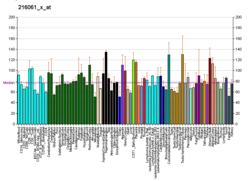PDGFB
Platelet-derived growth factor subunit B is a protein that in humans is encoded by the PDGFB gene.[5][6]
Function[]
The protein encoded by this gene is a member of the platelet-derived growth factor family. The four members of this family are mitogenic factors for cells of mesenchymal origin and are characterized by a motif of eight cysteines. This gene product can exist either as a homodimer (PDGF-BB) or as a heterodimer with the platelet-derived growth factor alpha (PDGFA) polypeptide (PDGF-AB), where the dimers are connected by disulfide bonds.
Clinical significance[]
Mutations in this gene are associated with meningioma. Reciprocal translocations between chromosomes 22 and 17, at sites where the PDGFB and COL1A1 genes are respectively located or, alternatively, an abnormal small supernumerary ring chromosome merge these two genes to form a COL1A-PDGFB fusion gene. This fusion gene greatly overproduces PDGFB and is considered responsible for causing the development and/or progression of three closely related fibroblastic and myofibroblastic tumors of the skin: giant cell fibroblastoma, dermatofibrosarcoma protuberans, and dermatofibrosarcoma protuberans, sarcomatous.[7]
Two splice variants have been identified for the PDGFB gene.[8]
See also[]
- Platelet-derived growth factor
References[]
- ^ a b c GRCh38: Ensembl release 89: ENSG00000100311 - Ensembl, May 2017
- ^ a b c GRCm38: Ensembl release 89: ENSMUSG00000000489 - Ensembl, May 2017
- ^ "Human PubMed Reference:". National Center for Biotechnology Information, U.S. National Library of Medicine.
- ^ "Mouse PubMed Reference:". National Center for Biotechnology Information, U.S. National Library of Medicine.
- ^ Ratner L, Josephs SF, Jarrett R, Reitz MS, Wong-Staal F (Sep 1985). "Nucleotide sequence of transforming human c-sis cDNA clones with homology to platelet-derived growth factor". Nucleic Acids Res. 13 (14): 5007–18. doi:10.1093/nar/13.14.5007. PMC 321845. PMID 2991848.
- ^ Clements JM, Bawden LJ, Bloxidge RE, Catlin G, Cook AL, Craig S, Drummond AH, Edwards RM, Fallon A, Green DR (Jan 1992). "Two PDGF-B chain residues, arginine 27 and isoleucine 30, mediate receptor binding and activation". EMBO J. 10 (13): 4113–20. PMC 453161. PMID 1661670.
- ^ Baranov E, Hornick JL (March 2020). "Soft Tissue Special Issue: Fibroblastic and Myofibroblastic Neoplasms of the Head and Neck". Head and Neck Pathology. 14 (1): 43–58. doi:10.1007/s12105-019-01104-3. PMC 7021862. PMID 31950474.
- ^ "Entrez Gene: PDGFB platelet-derived growth factor beta polypeptide (simian sarcoma viral (v-sis) oncogene homolog)".
Further reading[]
- Kurup S, Abramsson A, Li JP, Lindahl U, Kjellen L, Betsholtz C, Gerhardt H, Spillmann D (2006). "Heparan sulphate requirement in platelet-derived growth factor B-mediated pericyte recruitment". Biochem. Soc. Trans. 34 (Pt 3): 454–5. doi:10.1042/BST0340454. PMID 16709185.
- Genes on human chromosome 22
- Growth factors
- Human chromosome 22 gene stubs








